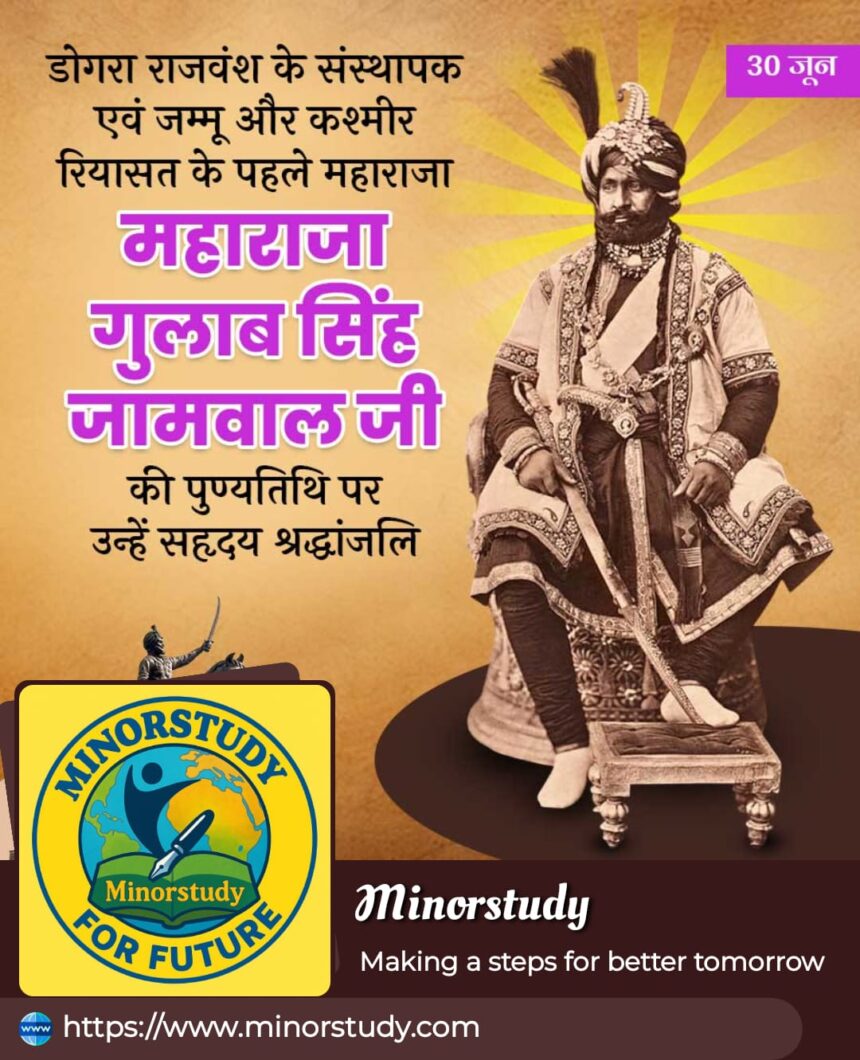👑 7 Underrated Yet Powerful Contributions of Maharaja Gulab Singh Jamwal That Changed Indian History Forever
Maharaja Gulab Singh Jamwal: In the grand annals of Indian history, certain names often glow like beacons—rare, dignified, and transformative. One such legacy belongs to Maharaja Gulab Singh Jamwal, the visionary founder of the princely state of Jammu and Kashmir and a man whose life was steeped in valor, diplomacy, and resilience.
- 🕰️ History of Maharaja Gulab Singh Jamwal
- 📜 Timeline of Major Life Events
- 🧠 Lesser-Known Yet Fascinating Facts
- 🌟 Significance of Maharaja Gulab Singh’s Rule
- 🎯 Observance and Cultural Relevance Today
- ❓ FAQs About Maharaja Gulab Singh
- Q1. Why is Maharaja Gulab Singh important in Indian history?
- Q2. Did Gulab Singh fight in wars?
- Q3. What was the Treaty of Amritsar?
- Q4. How did he contribute to religion and culture?
- 💐 Wishing & Reflective Messages
- 📈 Importance in Our Lives and Society
- 💬 Critical Points and Legacy Reflections
- ✍️ Conclusion: A Legacy That Demands Rediscovery
While the modern discourse often revolves around political divisions, Maharaja Gulab Singh’s efforts in the 19th century united fragmented lands, shaped strategic boundaries, and preserved regional identities in ways that still echo today.
This comprehensive and human-friendly article of 1200+ words uncovers his history, facts, timeline, significance, societal importance, and offers inspiring messages for the current generation.
🕰️ History of Maharaja Gulab Singh Jamwal
Born: 1792, Jammu
Died: 30 June 1857, Srinagar
Titles: Raja of Jammu (1822–1846), then Maharaja of Jammu and Kashmir (1846–1857)
Dynasty: Dogra Rajput family of Jamwal clan
Father: Mian Kishore Singh
Known for: Founder of the princely state of Jammu and Kashmir, first Dogra ruler of the region
📜 Timeline of Major Life Events
| Year | Event |
|---|---|
| 1792 | Birth in a noble Dogra Rajput family in Jammu |
| 1822 | Appointed Raja of Jammu by Maharaja Ranjit Singh of the Sikh Empire |
| 1846 | Signed the Treaty of Amritsar after the First Anglo-Sikh War, becoming the Maharaja of Jammu and Kashmir |
| 1846–1857 | Reigned as the first Maharaja, consolidating a multi-ethnic, multilingual, and geographically diverse state |
| 30 June 1857 | Passed away, succeeded by his son Ranbir Singh |
🧠 Lesser-Known Yet Fascinating Facts
Architect of a Unique Political State: Gulab Singh carved out Jammu & Kashmir as a distinct political unit—something that stood the test of time until the mid-20th century.
Signed the Treaty of Amritsar (1846): Through this treaty with the British, he legally purchased Kashmir for 75 lakh Nanakshahee rupees, a strategic masterstroke post Anglo-Sikh War.
Was a Sikh General: Before becoming a king, he was a general under Maharaja Ranjit Singh and played a crucial role in the expansion of the Sikh Empire.
A Patron of Temples and Culture: He invested heavily in religious sites, architecture, and educational institutions, promoting Dogra heritage.
Known for Administrative Reforms: His rule brought taxation reforms, stability in trade routes (Silk Road links), and improved military logistics in the tough Himalayan terrains.
🌟 Significance of Maharaja Gulab Singh’s Rule
1. 🗺️ Geo-political Genius
At a time when India was a chessboard of empires, Gulab Singh’s diplomatic prowess created a kingdom that bordered Tibet, Afghanistan, Punjab, and British India. This made Jammu & Kashmir a strategic hub of South Asia.
2. 🛡️ Balancer of Powers
He skillfully navigated relations with the British Raj and the Sikh Empire, choosing political pragmatism over blind loyalty. His neutrality during the First Anglo-Sikh War enabled him to negotiate from a position of strength.
3. 🏔️ Unifier of Diverse Ethnicities
He ruled over Ladakh, Baltistan, Gilgit, Jammu, and Kashmir—areas with vastly different ethnic, linguistic, and cultural populations. His ability to keep them under one administrative umbrella shows statesmanship beyond his time.
🎯 Observance and Cultural Relevance Today
Though not widely celebrated as a festival, historical remembrance programs, academic seminars, and Dogra heritage events pay tribute to Gulab Singh in Jammu and parts of North India.
In recent years, there have been calls for declaring his birth or coronation day as a public holiday in Jammu & Kashmir to honor his monumental legacy.
❓ FAQs About Maharaja Gulab Singh
Q1. Why is Maharaja Gulab Singh important in Indian history?
He was the founder of the princely state of Jammu & Kashmir, played a strategic role in post-Sikh war diplomacy, and laid the foundation of a region that continues to be central in South Asian geopolitics.
Q2. Did Gulab Singh fight in wars?
Yes, he was a seasoned general under Maharaja Ranjit Singh and fought in various campaigns including those in Ladakh and Baltistan.
Q3. What was the Treaty of Amritsar?
Signed in 1846 between the British and Gulab Singh, it legalized his purchase of Kashmir, making him its sovereign ruler.
Q4. How did he contribute to religion and culture?
He supported Hindu temples, Sanskrit learning, and Dogra architecture, while respecting the Islamic traditions of Kashmir and the Buddhist practices of Ladakh.
💐 Wishing & Reflective Messages
“On remembering Maharaja Gulab Singh Ji, may we be inspired to lead with courage and wisdom.”
“Tributes to the architect of Jammu & Kashmir — a man of vision, strength, and diplomacy.”
“May his fearless spirit guide today’s leaders in building unity across diversity.”
📈 Importance in Our Lives and Society
Personal Relevance:
Leadership Lessons: Stand by strategy, not sentiment alone.
Cultural Pride: Embrace your heritage while adapting to modernity.
Unity Through Diversity: Accept and respect all cultures within a shared space.
Societal Impact:
Laid the foundation of modern political boundaries in the north.
Created a multi-faith administrative model, showcasing coexistence long before modern federal ideas.
His state later became a focal point in post-independence negotiations between India and Pakistan.
💬 Critical Points and Legacy Reflections
His reign offers a template for regional unity and resilience.
While he made a political transaction with the British, he also retained autonomy and dignity, something rare in the colonial era.
His descendants ruled until 1947, keeping the Dogra lineage alive for over a century.
✍️ Conclusion: A Legacy That Demands Rediscovery
Maharaja Gulab Singh Jamwal Ji was not merely a king—he was a visionary, a negotiator, and a symbol of calculated courage. His decisions, often misinterpreted, were deeply rooted in political foresight and the long-term welfare of his people.
In today’s world, where conflict and division often overshadow unification and diplomacy, remembering Gulab Singh is a reminder that a ruler’s true power lies not just in conquest, but in consolidation, culture, and character.








